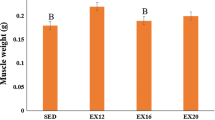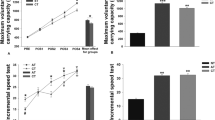Summary
The purpose of this study was to investigate the adaptability of long bones of young adult rats to the stress of chronic aquatic exercise. Twenty-eight female Sabra rats (12 weeks old) were randomly assigned to two groups and treatments: exercise (14 rats) and sedentary control (14 rats) matched for age and weight. Exercised animals were trained to swim in a water bath (35°±1°C, 1 hour daily 5 times a week) for 12 weeks loaded with lead weights on their tails (2% of their body weight) (BW). At the end of the training period following blood sampling for alkaline phosphatase, all rats were sacrificed and the humeri and tibiae bones were removed for the following measurements: bone morphometry, bone water compartmentalization, bone density (BD), bone mineral content (BMC), and bone ions content (Ca, Pi, Mg, Zn). The results indicate that exercise did not significantly affect the animals' body weight, bone volume, or length and diameters. However, bone hydration properties, BD, bone mass, and mineralization revealed significant differences between swim-trained rats and controls (P<0.05). Longitudinal (R1) measurement was higher by 43% for both humerus and tibia, and Transverse (R2) relaxation rates of hydrogen proton were higher by 117 and 76% for humerus and tibia, respectively; fraction of bound water was higher by 36 and 46% for humerus and tibia, respectively. BD, bone weight, and ash were higher by 13%. BMC and bone ions content were higher by 10%, and alkaline phosphatase was higher by 67%. These results indicate that long bones of young adult rats after the age of rapid growth can adapt positively to nonweight-bearing aquatic exercise. This adaptation is evident by an increase in bone mass, density, mineralization, and hydration properties.
Similar content being viewed by others
References
Donaldson HH (1933) On the effect of exercise beginning at different ages on the weight of the musculature and of several organs of the albino rat. Am J Anat 53:402–411
Donaldson HH (1935) Summary of data for the effects of exercise on the organ weights of the albino rat: comparison with similar data for the dog. Am J Anat 56:57–70
Steinhaus AH, Hoyt LA, Rice HA (1932) Studies on the physiology of exercise. X. The effects of running and swimming on the organ weights of growing dogs. Am J Physiol 99:512–520
Saville PD, Whyte MP (1969) Muscle and bone hypertrophy: positive effect of running exercise in the rat. Clin Orthop 65:81–88
King DW, Pengelly RG (1973) Effect of running on the density of rat tibias (abstract). Med Sci Sports 5:68–69
Chvapil M, Bartos D, Bartos F (1973) Effect of long-term physical stress on collagen growth in lung, heart and femur of young and adult rats. Gerontologica 77:263–270
Schryver HF, Hintz HF, Lowe JE (1978) Calcium metabolism, body composition and sweat losses of exercised horses. Am J Vet Res 39:245–248
Bauer K, Griminger P (1984) Long-term effects of activity, calcium and phosphorus on bones and kidneys of female rats. Nutr Rep Int 29:1029–1038
Beyer RE, Haung JC, Wilshire GB (1985) The effect of endurance exercise on bone dimension, collagen and calcium in the aged male rat. Exp Gerontol 20:315
Kiiskinen A, Heikkinen E (1978) Physical training and connective tissues in young mice: biochemistry of long bones. J Appl Physiol Resp Environ Exercise Physiol 44(1):50–54
McDonald R, Hegenauer J, Saltman P (1985) Calcium metabolism and bone mineralization in aged rats following exercise. Gerontologist 25–56
Ringe JD, Steinhagen-Theissen E (1985) Prevention of physiological age-dependent bone atrophy by controlled exercise in mice. Age 2:44–47
Steinberg ME, Trueta J (1981) Effect of activity on bone growth and development in the rat. Clin Orthop Rel 156:52
Woo SL, Kuel CC, Amiel D, Gomez MA, Hayes WC, White FC, Areson WH (1981) The effect of prolonged physical training on the properties of long bone: a study of Wolff's law. J Bone Joint Surg 63-A:(5)780
Vaugham CL (1984) Biomechanics of running gait. CRC Crit Rev Biomed Eng 12:1–48
Swissa-Sivan A, Simkin A, Leichter I, Nyska A, Nyska M, Statter M, Bivas A, Menczel J, Samueloff S (1989) Effect of swimming on bone growth and development in young rats. Bone Miner 7:91–105
Hazan G, Leichter I, Loewinger E, Weinreb A, Robin GC (1977) The early detection of osteoporosis by Compton gamma ray spectroscopy. Phys Med Biol 22:1073–1084
Frost HM (1987) Bone “mass” and the “mechanostat”: a proposal. Anat Rec 219:1–9
Author information
Authors and Affiliations
Rights and permissions
About this article
Cite this article
Swissa-Sivan, A., Azoury, R., Statter, M. et al. The effect of swimming on bone modeling and composition in young adult rats. Calcif Tissue Int 47, 173–177 (1990). https://doi.org/10.1007/BF02555984
Received:
Revised:
Issue Date:
DOI: https://doi.org/10.1007/BF02555984




